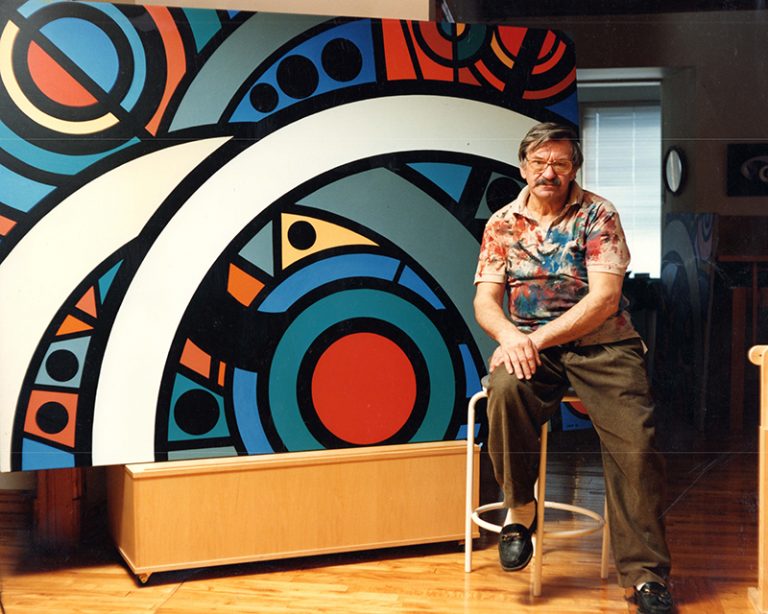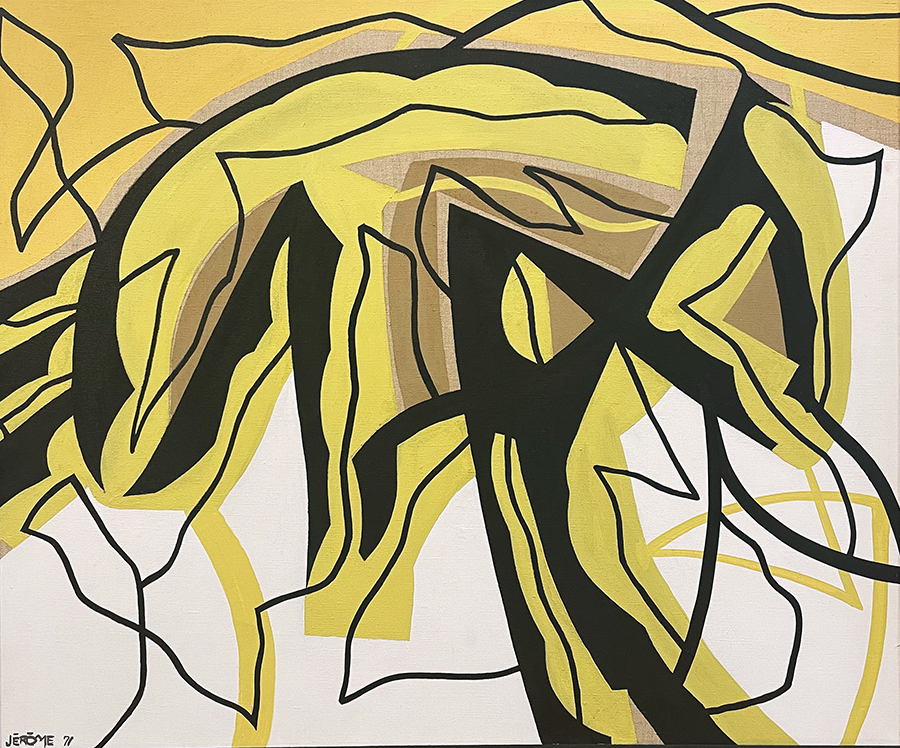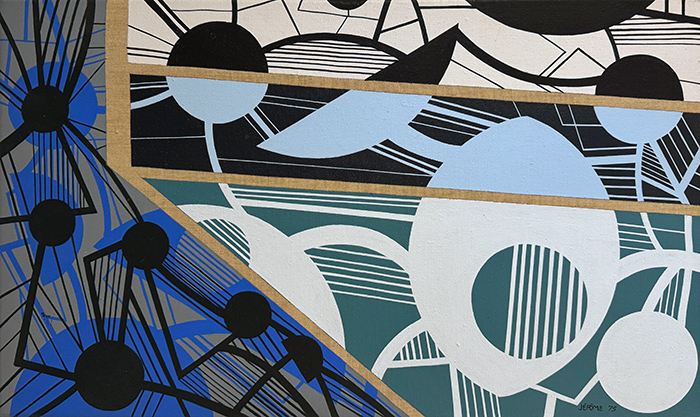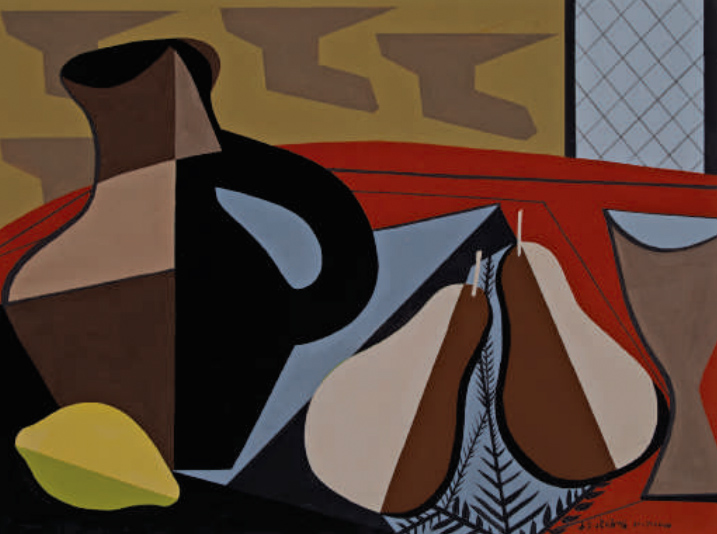Jean-Paul Jérôme
Jean-Paul Jérôme (1928-2004) Biography
Jean-Paul Jérôme was born in Montreal on February 19, 1928. An early aptitude for drawing led him to enroll in the Montreal School of Fine Arts where, from 1945 to 1952, he studied the art and technique of fresco painting under the tutelage of Stanley Cosgrove. In 1953, following a period during which he dedicated himself to cubist-influenced landscapes and still lives he shifted towards abstract painting.
Eventually, his approach to art began to incorporate geometric concepts and in 1955, along with three painter friends – Rodolphe de Repemtigny, Louis Belzile and Fernand Toupin- Jerome co-founded the Plasticien Movement, publishing their Manifesto in February of the same year, the guidelines of which, based on Cézanne’s and Mondrian’s, were to exert a strong influence on the trajectory of Quebec art.
From 1956 to 1958, in order to further his creativity, Jerome studied in Paris, where he met Giacometti and Vasarelly and developed his passion for achieving perfect harmony between shapes and colours, eventually exhibiting his work in the fall of 1957 at Galerie Arnaud. Upon his return to Canada in November 1958, Jerome began to teach at the Montreal School of Fines Arts. He remained there until 1973 when he decided to finally devote himself entirely to his art and move into a dedicated studio on the south shore of the St- Laurence river, in St-Ours sur le Richelieu.
Hundreds of exhibitions and many honours followed - In 1978, the Royal Canadian Arts Academy admitted him in recognition of his outstanding contribution to the arts. In 2003, the Musée du Bas Saint-Laurent mounted an encapsulating retrospective that toured Canada over the next four years. In 2005, the Musée des Beaux Arts de Sherbrooke devoted an outstanding retrospective to the Plasticiens, to celebrate the fiftieth anniversary of their Manifesto, and thus highlighted many of Jean-Paul Jérôme’s works. Sadly, Jerome could not attend this celebration as he died in his seventy-sixth year, on August 14, 2004. A forceful and keen painter, he dedicated his entire life, up to the very last moments, to painting: “Enraptured by life” was the title he gave to his last painting, a prophetic and fitting work that sums up his entire approach and outlook.
Selected Exhibitions
1951 Musée des Beaux-Arts de Montréal, Salon du printemps, Montréal
1952 Musée des Beaux-Arts de Montréal, Salon du Printemps, Montréal
1953 Musée des Beaux-Arts de Montréal, Salon du Printemps, Montréal
1955 Galerie l’Echouerie, Exposition du groupe des Premiers Plasticiens Belzile, Jauran, Jérôme et Toupin, lancement du Manifeste des Plasticiens, 10 février au 2 mars 1955, Montréal.
1955 Galerie l’Actuelle, exposition inaugurale de la galerie L’Actuelle, Les Plasticiens et Fernand Leduc y participent, 28 mai au 23 juin 1955, Montréal (Québec)
1956 Galerie Nationale du Canada, Ottawa
1957 Galerie Arnaud, 24 octobre au 6 novembre 1957, Paris (France)
1967 Musée d’Art Contemporain de Montréal, Panorama de la peinture du Québec (1940-1966), Montréal
1975 Musée d’art contemporain de Montréal, collection permanente, mars 1975, Montréal
1977 Musée d’art contemporain de Montréal, Jauran et les premiers plasticiens
1992 Musée du Québec, Exposition de groupe La Crise de l’abstraction au Canada / Les années 50, Québec (Québec)
2005 Musée de Sherbrooke, 50e anniversaire des Plasticiens, 11 juin au 18 septembre 2005, Sherbrooke
2012-2016 Musée d’art contemporain de Montréal. Exposition de groupe La question de l’abstraction, 12 avril 2012 au 4 janvier 2016, Montréal (Québec)
2013 Musée National des Beaux-Arts du Québec. L’exposition « Les Plasticiens et les années 50-60
Selected Collections
Musée des Beaux-arts du Canada à Ottawa
Musée des Beaux-Arts de Montréal
Musée National des Beaux-Arts du Québec à Québec
Musée d’Art Contemporain de Montréal
Musée d’Art de Joliette
Musée du Bas-Saint-Laurent à Rivière-du-Loup
Musée des Beaux-Arts de Sherbrooke
National Gallery of Canada, Ottawa ON
La Pulperie de Chicoutimi
Université de Montréal
Université de Sherbrooke
Artist Specialization - Geometric Abstraction - Despite his steadfast commitment to the Plasticien manifesto and its focus on geometric abstraction, Jean-Paul Jérôme expressed himself through a variety of materials and artistic expression: his oil and acrylic paintings rest on wood , glass, pottery, tapestry and stained-glass as well as on paper and cardboard, as well as via a vast array of pastel, charcoal, red chalk and sepia drawings. His sculptures, on brass or on wood, his reliefs and his monumental concrete architectural structures match the grandeur and ambition of his painting. “I have been attracted all my life to perfect shapes, to colourful overtones”, he delighted in saying.




